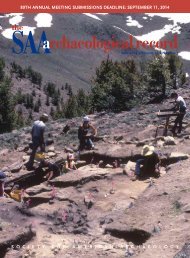SAA
SAA_Record_Nov2015
SAA_Record_Nov2015
You also want an ePaper? Increase the reach of your titles
YUMPU automatically turns print PDFs into web optimized ePapers that Google loves.
PROS AND CONS OF CONSULTING COLLECTORS<br />
INTRODUCTION TO THE THEME “PROS AND<br />
CONS OF CONSULTING COLLECTORS”<br />
Michael J. Shott and Bonnie Pitblado<br />
Michael J. Shott is in the Department of Anthropology & Classical Studies, University of Akron, Akron, Ohio.<br />
Bonnie Pitblado is in the Department of Anthropology, University of Oklahoma, Norman, Oklahoma.<br />
We begin with truisms. First, much of the archaeological<br />
record lies on or near the modern surface<br />
in arid lands like the American West and cultivated<br />
landscapes like the Midwest and Southeast. Second, what<br />
lay people call “arrowheads” will catch the eye and appeal<br />
equally to an urge for discovery and a sense of wonder about<br />
the unknown, whereas sherds, bone fragments, and the like<br />
often pass unrecognized or neglected. Third, there are many<br />
more lay people who possess urges, not to mention free<br />
time, to walk fields and deserts than there are archaeologists<br />
who possess professional sensibilities, and these lay people<br />
are much more widely distributed. Fourth, therefore, over<br />
the past 150 years, lay people have amassed many more and<br />
vastly larger collections of “arrowheads” than we have, often<br />
from the very sites that attract archaeologists for scholarly or<br />
preservation reasons.<br />
We can’t stop collection. As David Thulman aptly put it, urging<br />
collectors to stop is as practical as “yelling at the tide to<br />
stop coming in” (2011:10). Instead, archaeology traditionally<br />
has chosen two options: ignoring collecting and collectors, or<br />
engaging and educating them for our mutual benefit. (To<br />
their credit, some federal agencies involve local citizens in<br />
monitoring and research.) Although neglect seems more<br />
common, we believe that collaboration is the better option,<br />
improving collectors’ practice and promoting the preservation<br />
of the record that we all profess to serve.<br />
Why Collaborate: Preservation and Research<br />
There are many good reasons that justify, even demand, collaboration<br />
with private collectors. Here we emphasize only<br />
one: the surface record often seems impoverished of points.<br />
Compliance surveys often produce “nondiagnostic scatters”<br />
that, by definition, we dismiss as uninformative and condemn<br />
to oblivion (Cain 2012). Scatters may be inherently<br />
“nondiagnostic,” but there is another explanation:<br />
Recurrent collecting badly biases the surface remains<br />
at a site, especially depleting the artifacts, such as projectile<br />
points … that archaeologists use for chronological<br />
control. In severely collected sites … the surface<br />
remains … become undesirably monotonous: a few<br />
small, undecorated sherds and lithic flakes (Schiffer<br />
1996:116).<br />
Baxter (2013), among others, documented such collection<br />
effects. If we troubled ourselves to consult the private collectors<br />
who often have collected from sites, we may learn, first,<br />
that they possess many diagnostic artifacts from where we<br />
found few (Shott 2015; Thulman 2011), and, second, that<br />
when cross-referenced to collections, many “nondiagnostic”<br />
sites become Clovis camps, Basketmaker hamlets, or Mississippian<br />
villages. Some may distrust collectors’ honesty. A few<br />
may lie, but our blithe neglect of their information almost<br />
certainly condemns many worthy sites to oblivion. If we do<br />
not document collections, such as in Phase I fieldwork<br />
(Blakemore et al. 2008:158), for instance, we ignore what in<br />
the aggregate is a sizeable dataset on particularly informative<br />
parts of the archaeological record, to the detriment of the<br />
record’s preservation.<br />
Besides preservation, there are research benefits to collaboration,<br />
which require much greater reflection than is possible<br />
here. Only large, reasonably well-documented point<br />
datasets— the very kinds that only documentation of private<br />
collections will yield— can gauge the full range of point<br />
types’ variation by toolstone, technology, curation, and spatial<br />
distribution and association with other types, with pottery<br />
types, by landform, etc.<br />
With Whom to Collaborate<br />
Many people collect artifacts, but not all deserve our support.<br />
We believe that collaboration is warranted only with private<br />
collectors who:<br />
November 2015 • The <strong>SAA</strong> Archaeological Record<br />
11




